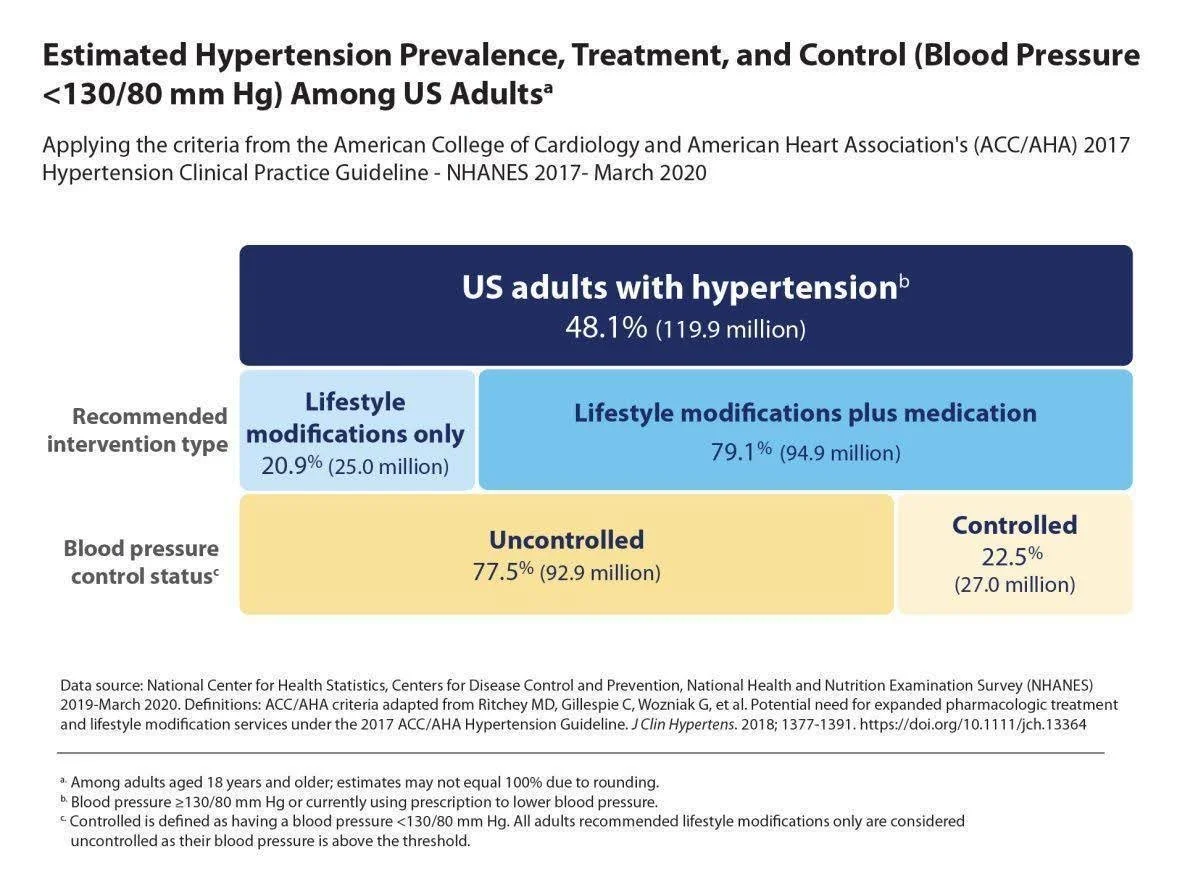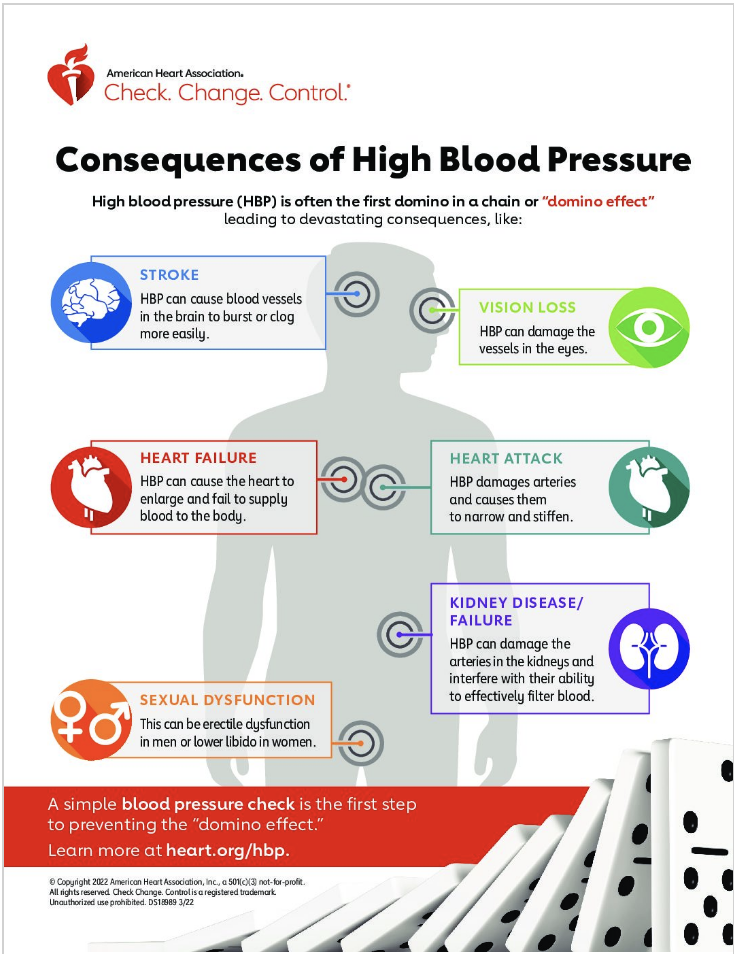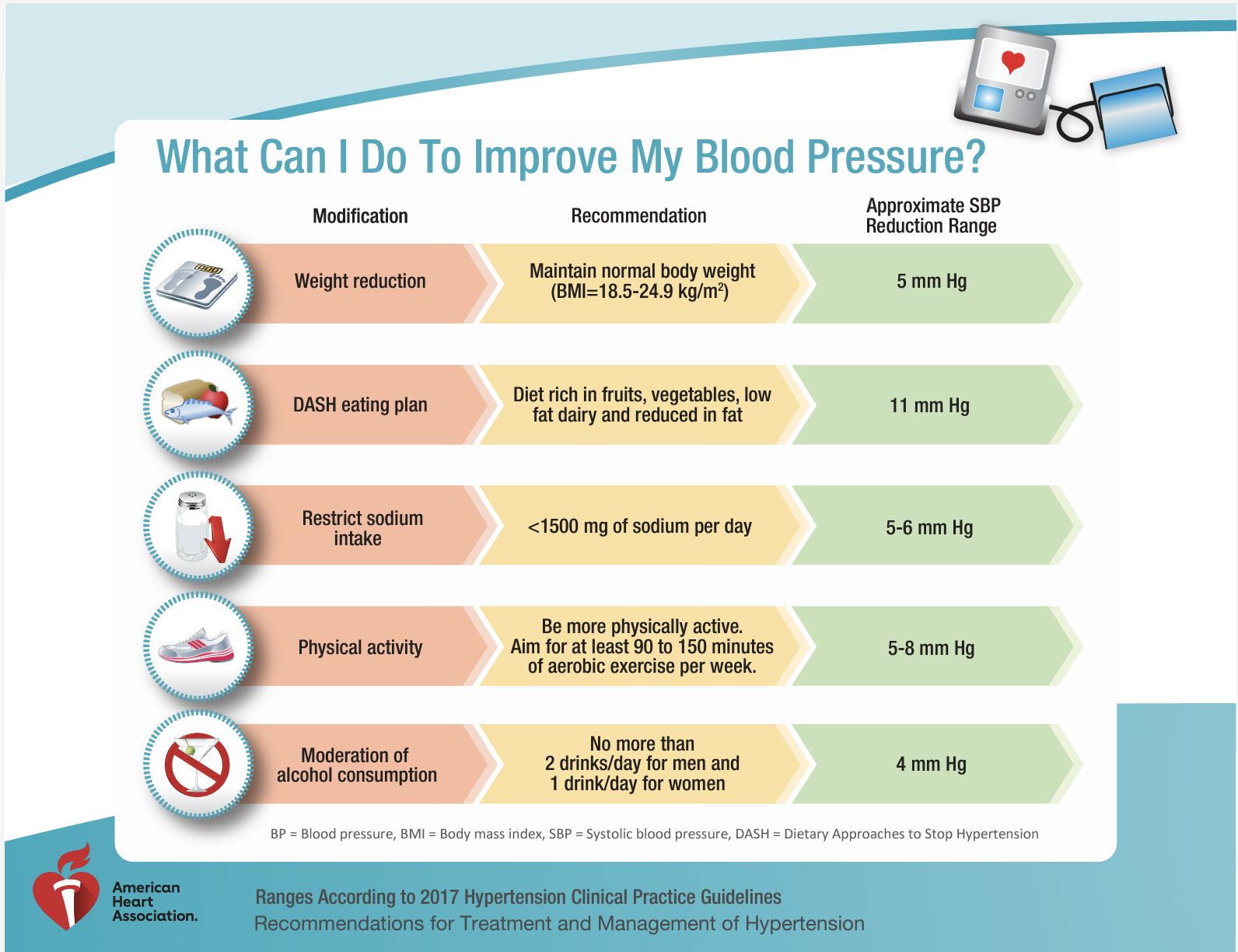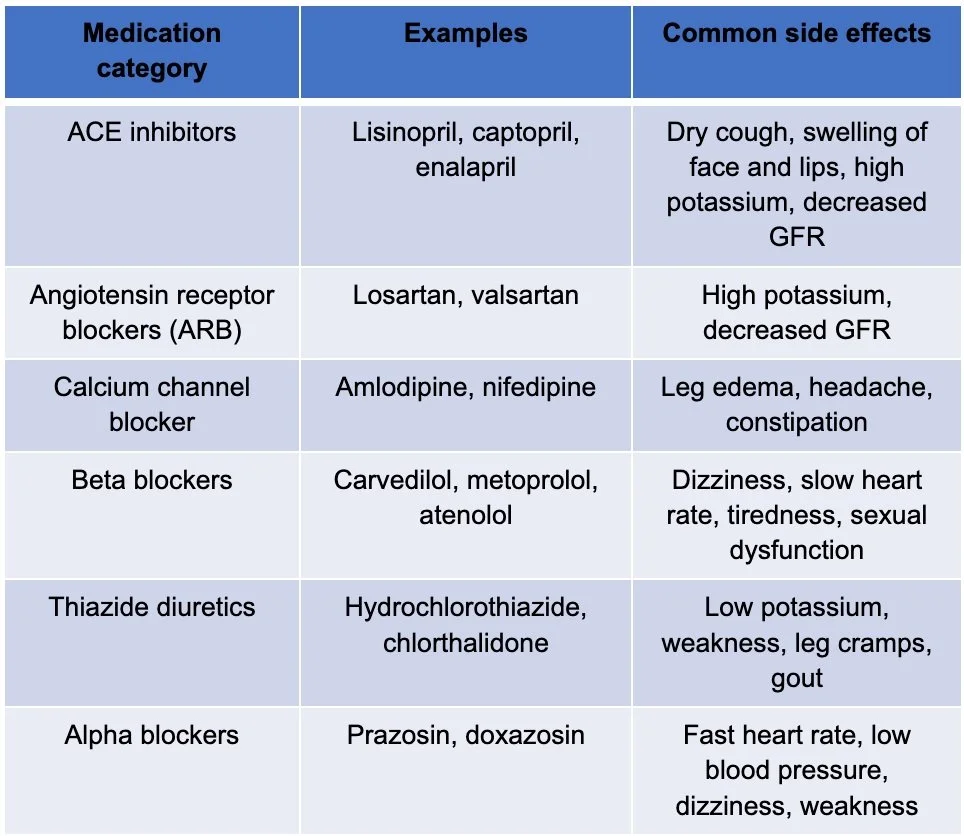Hypertension: “The Silent Killer”
By: Priya Patel MD, Jonathan Kahan MD
What you need to know
High blood pressure, defined as a blood pressure of >130/80 mmHg is called the “silent killer” as it is highly prevalent (1 in 3 people worldwide) and is a major risk factor for heart attacks, strokes, kidney disease and death.
Goal blood pressure should be <130/80 mmHg for most people, with the ideal goal of <120/80 mmHg for most. Measuring blood pressure is tricky and there are strict steps to follow to check.
Treating blood pressure works! We have large, very well-done trials showing the enormous benefits of having normal blood pressures
Lifestyle changes, such as diet, weight loss and exercise work, as well as medications, and are the mainstay of treatment initially for everyone
For those who cannot achieve blood pressure goals, we have good classes of medications to get to our goal.
Small particles (smoke, cholesterol, pollution) moving at high velocity (ie. High blood pressure), lead to plaque formation in the arteries (which is the cause of most cardiovascular pathology), in the background of chronic inflammation. High blood pressure alone can create inflammation.
What is high blood pressure?
Blood pressure is the pressure of blood pushing against the walls of your arteries measured in millimeters of mercury (mmHg) as seen in the picture below. Arteries carry blood from your heart to other parts of your body. Your blood pressure normally rises and falls throughout the day. The top number of blood pressure is when the heart squeezes (systolic blood pressure) and the bottom number is when the heart relaxes (diastolic blood pressure). High blood pressure is blood pressure higher than normal and if persistently elevated may result in the diagnosis of hypertension (1).
How do we define high blood pressure?
As per the American Heart Association (AHA) guidelines, hypertension is diagnosed when systolic blood pressure (SBP) in the office or clinic is ≥130 mm Hg and/or their diastolic blood pressure (DBP) is ≥80 mm Hg following repeated examination (2). Usually 2–3 office visits at 1–4-week intervals (depending on the BP level) are required to confirm the diagnosis of hypertension. The diagnosis might be made on a single visit, if BP is ≥180/110 mm Hg and there is evidence of cardiovascular disease (CVD) (3). Normal blood pressure is less than 120/80 mmHg.
How common is high blood pressure?
In 2021, hypertension was a primary contributing cause of 691,095 deaths in the United States and affects one out of every three people globally!
Nearly half of adults have hypertension (48.1%, 119.9 million). About 1 in 4 adults with hypertension have their hypertension under control (22.5%, 27.0 million).
High blood pressure costs the United States about $131 billion each year, averaged over 12 years from 2003 to 2014. (4)
Why should I care about high blood pressure?
Having prolonged untreated blood pressure has many consequences, one of which is a stroke, either a hemorrhagic stroke (bleed in the brain) or ischemic stroke where a clot breaks off and stops blood flow to the brain. Other adverse outcomes include vision loss by damaging blood vessels in the eyes, erectile dysfunction and congestive heart failure.
High blood pressure alone can create mechanical stress on blood vessels, reducing nitric oxide levels, which causes the expression of inflammatory markers (IL-1, IL-6, TNFα, CRP) and immune system activation, which leads to plaque formation. Additionally, it actives the renin-angiotensin-aldosterone system in our kidney, which creates reactive oxygen species. This creates a vicious cycle of high blood pressure causing inflammation leading to higher blood pressure.
It can also cause a heart attack by causing more stress on the heart causing a supply-demand mismatch and breaking off of plaque leading to a blockage. Untreated high blood pressure can also lead to heart failure, which is a scary term but over time, high blood pressure causes thickening of the left ventricle, the main pumping chamber of the heart. Eventually, the left ventricle becomes thin, dilated and does not pump well leading to its own set of complications.
Small particles (smoke, cholesterol, pollution) moving at high velocity (ie. High blood pressure), can also lead to plaque formation in the arteries (which is the cause of most cardiovascular pathology), in the background of chronic inflammation.
How do I check my blood pressure?
When measuring blood pressure, ideally you should not have exercised, smoked, or had caffeine in the last 30 minutes.
Don’t eat or drink anything 30 minutes before you take your blood pressure.
Empty your bladder before checking your blood pressure.
Sit in a comfortable chair with your back supported for at least 5 minutes before your reading.
Put both feet flat on the ground and keep your legs uncrossed.
Rest your arm with the cuff on a table at chest height.
Make sure the blood pressure cuff is snug but not too tight. The cuff should be against your bare skin, not over clothing.
Do not talk while your blood pressure is being measured (2).
Even a new blood pressure cuff can be inaccurate 15% of the time. It is important to correlate home blood pressure cuff with blood pressure cuff at your doctor’s office.
What symptoms can I experience with high blood pressure?
Most individuals are asymptomatic (which is why high blood pressure is called “the silent killer”), other symptoms that you can experience include (7):
Headaches
Blurred vision
Nocturia (urinating at night)
Hematuria (blood in the urine)
Dizziness
Chest pain
Shortness of breath
Palpitations
What are the risk factors for high blood pressure?
Risk factors can be broken down into modifiable and relatively fixed risk factors (2):
Modifiable risk factors include:
Diabetes mellitus
Obesity
Dyslipidemia/hypercholesterolemia
Physical inactivity
Obstructive sleep apnea
Unhealthy diet
Relatively fixed risk factors include:
Chronic kidney disease
Genetics/family history
Age
Why do people have high blood pressure?
The short answer is we do not have just one cause, but rather multiple different etiologies such as genetics, dietary salt intake, obesity, sedentary lifestyle, increased alcohol intake, stress can all lead to high blood pressure (8).
Obesity-related hypertension is caused by a complex neuro-hormonal cascade in the body that activates pathways in the brain, kidneys and adipose tissue (fat cells) leading to hypertension. A similar process occurs with stress. Increased stress may be due to a job, a visit to the doctor’s office, social/environmental or emotional stressors can increase release of vasoconstricting hormones that increase blood pressure (9).
What about salt?
You will hear us talk incessantly about salt. Why does salt intake matter because salty things taste good, right? Well, this is true but salt causes the body to retain water which increases total blood volume resulting in increased blood pressure. So, you may be asking, what can I do? First, take the salt shaker off the table (our goal daily salt intake is less than 2.5 grams). Second, just having one glass of water before eating a salty meal (such as a restaurant) will help control your blood pressure by reducing the blood osmolarity (salt concentration relative to blood volume) from salt intake to reduce the spike in blood pressure (10). Fascinating, I know.
You still with me? Don’t fall asleep because we have a bit more to talk about.
What are other causes of high blood pressure?
I won’t bore you with the details but here are some other terms and causes of to be aware of:
Primary or commonly referred to as essential hypertension is the most common cause of high blood pressure in the general population and the etiology is unknown but we do know that obesity, poor diet, high alcohol intake, increased salt intake can lead to essential hypertension. It typically begins in those over the age of 30, and often with a family history of hypertension (8).
Secondary hypertension is related to a specific etiology and is often resistant to treatment. It can be sudden in onset or be labile and difficult to control especially in a person without family history. Some causes to be aware of are below (8,11):
Obstructive sleep apnea
Primary aldosteronism
Renal parenchymal disease like chronic kidney disease, polycystic kidney disease, glomerulonephritis
Renovascular disease like renal artery stenosis or fibromuscular dysplasia
Endocrine or hormonal dysregulation like Cushing’s syndrome, hyperthyroidism/hypothyroidism, primary hyperparathyroidism, pheochromocytoma/paraganglioma
Vascular or blood vessel disorder like aortic coarctation or aortitis/vasculitis
How do I control my high blood pressure?
Before we get in the how, we need to go over the blood pressure goals and when we start treating high blood pressure. When blood pressure remains over >140/>90, we start treating with medications (2).
The goal for basically everyone is to have a blood pressure of <130/<80 mmHg (2)
The higher the risk you are for heart attacks and strokes, the more important treating blood pressure becomes. The tradeoffs are things like dizziness, passing out and kidney injury from low blood pressure.
Women with hypertension who are pregnant or planning to get pregnant should be transitioned to labetalol, methyldopa, and nifedipine during pregnancy. Goal blood pressure is 140/90 as per American College of Gynecology guidelines (12).
Now that we have discussed what the treatment goal for blood pressure should be, let’s talk about how to manage it.
Diet, weight loss and exercise are by far the best treatment for blood pressure.
The Dietary Approaches to Stop Hypertension (AKA DASH) diet which includes eating vegetables, fruits and whole grains including fat free or low-fat dairy products, fish, poultry, beans, nut and vegetable oils. Limit foods high in fatty meats and limit sugar sweetened beverages and sweets which can lead to about 11 mmHg drop in blood pressure. Sugar intake increases stimulation of the sympathetic nervous system in the brain activating a neuro-hormonal cascade and causes vasoconstriction causing blood pressure to rise (13).
Decreasing salt intake to less than 2.3 grams of salt per day can lead to an additional 5-6 mmHg decrease in blood pressure (14).
Weight loss, ideally to lose about 1 kg of weight and expect about 1 mmHg decrease in blood pressure with every 1 kg reduction in body weight (2).
Physical activity (see exercise section for a much more complete guide):
Aerobic activity about 90 to 150 minutes per week, target heart rate 65- 75% of your age (2)
Dynamic Resistance about 90 to 150 minutes per week, target heart rate 50-80% of your age (2)
Isometric Resistance to be done 4 times for 2 minutes, 1 minute rest between exercises. Do 30-40% maximum voluntary contraction, 3 sessions per week for 8-10 weeks. (2)
Limit alcohol consumption, reduce to < 2 drinks per week or cessation of alcohol use (2).
I have done all the changes, yet lifestyle isn’t enough! `
When lifestyle isn’t enough, we give you a boost with medications and we have multiple medications in our armament to choose from as the first line. The class of medications that are first line are the calcium channel blockers, the thiazide diuretics and the angiotensin receptor blockers/angiotensin converting enzymes. Remember our goal is <130/80 mmHg most days.
thiazide and thiazide-like diuretics such as chlorthalidone, hydrochlorothiazide, metolazone or indapamide. These medications are “water pills” and will make you urinate frequently in order to reduce blood volume. Common side effects include electrolyte abnormalities, dizziness, lightheadedness, and dehydration (16).
Calcium channel blockers like amlodipine, nifedipine, felodipine are vasodilators and cause dilation of blood vessels and decrease blood pressure. These medications provide a steady control of blood pressure throughout the day without spikes. Common side effects lower extremity swelling (most common), headache and constipation (16).
ACE inhibitors like enalapril, lisinopril and angiotensin receptor blockers (ARB) like Valsartan, Losartan, Olmesartan. These medications dilate blood vessels in the kidneys to reduce blood pressure. This group of medications are often first line in patients with diabetes mellitus, chronic kidney disease, heart failure. Common side effects include cough (more with ACE inhibitors), elevation in renal function (temporarily), hyperkalemia (elevated blood potassium level), angioedema (facial swelling). After starting these medications, repeat labs are done within 1-2 weeks to check renal function and potassium levels (16).
Beta blockers like atenolol, metoprolol, carvedilol or labetalol can be used for blood pressure but often not the first choice (because they are weaker) unless some has a history of heart attack, heart failure or tachycardia (fast heart rate). Common side effects include fatigue, slow heart rate and sexual dysfunction (16). Other blood pressure medications that can be used include loop diuretics like furosemide or torsemide.
Potassium sparing diuretics like eplerenone or spironolactone can be used in resistant hypertension cases or in patients with heart failure.
Less common medications include minoxidil, clonidine and alpha blockers like terazosin or prazosin.
Key Points: Hypertension Management
Hypertension, defined as a blood pressure of >130/80 mmHg most days, is known as the silent killer as it is the cause of most heart attacks and strokes
We have excellent medications to treat this, however lifestyle, weight loss and exercise plays an outsized role here. Focus on the other topics in this book to treat.
Some people are salt sensitive, drink water before a salty meal to reduce the risk. Sleep apnea is a major underdiagnosed cause as well.






